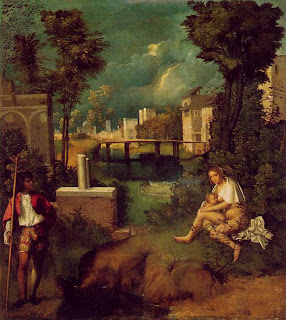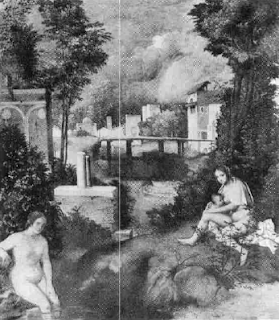Tuesday, August 10th, 2010
I came across this stunning image of from the back of King Tut’s gold throne (left, c. 1332-1322 BC) tonight. Isn’t it gorgeous? (Click on the image to enlarge it, if you don’t believe me.) I love the striking, bold colors. And I especially love that Tutankhamun is depicted with the lil’ Amarna-style belly that his dad popularized in Egyptian art (see the relief Ahkenaten and His Family, c. 1353-1336 BC, for one another example of the Amarna style).
This throne shows Tutakhamun being anointed with perfume by his wife, Ankhesenamun. I love the fine details in Ankhesanumun’s robe, and I especially love that you can see the outline of her legs beneath the flowing material. It gives the impression that the material is very lightweight. (There is a little more information about this throne here.)
Speaking of King Tut, have you seen the reconstruction of his face? In 2005, National Geographic reported that scientists used 3-D CT scans to reconstruct the first mummy of the ancient pharaoh. Kinda cool, but also kinda creepy. Check out this image of the bust on display at the Field Museum in Chicago – it totally reminds me of the heads that the witch Mombi stored in the “Return to Oz” movie. Yikes!
Friday, August 6th, 2010
My friend Jon just sent me this article. I was glad to see that admission is free to this museum – it would be entertaining to visit, but I wouldn’t want to pay anything in order to see “bad art!”
It sounds, though, like this museum is able to turn “bad art” into something somewhat positive (gasp!) and entertaining. I enjoyed the quote in the article by Louise Reilly Sacco (the co-founder of the museum): “We celebrate these pieces, and we enjoy them. Once you get beyond the name of the museum, we never say bad things about them.”
What do you think? Do you think it’s right for someone to stipulate if art is “bad?” (I don’t have a problem with it, but I could see how such an idea could be controversial.) Would you visit such a museum? Would you pay for admission?
*You can check out the website for the Museum of Bad Art (MOBA) here.
Thursday, August 5th, 2010
 Recently I have been reading some back-and-forth discussion on Three Pipe Problem regarding interpretations of Giorgione’s Tempest (c. 1505, shown right). Whenever I teach this painting to students, I give some background on the extant interpretations and scholarship, but I have never promoted one theory above another. The reason? In my opinion, it’s just too hard. I haven’t found one interpretation that completely satisfies all of my questions regarding the enigmatic subject matter and composition.
Recently I have been reading some back-and-forth discussion on Three Pipe Problem regarding interpretations of Giorgione’s Tempest (c. 1505, shown right). Whenever I teach this painting to students, I give some background on the extant interpretations and scholarship, but I have never promoted one theory above another. The reason? In my opinion, it’s just too hard. I haven’t found one interpretation that completely satisfies all of my questions regarding the enigmatic subject matter and composition.
One of the more popular arguments is that this painting is a Flight into Egypt scene, although that argument still leaves me with some questions. X-ray scans of the painting reveal that Giorgione first painted a woman on the left side of the painting (see below, as reconstructed by Morassi in 1939), and then later changed his mind and painted the woman on the right (which is why both women appear in the x-ray scan. For someone who is familiar with the final painting, this scan almost seems creepy at first glance, since the male figure eerily nonexistent.).
Anyhow, the woman revealed through x-ray is not holding an infant, nor is she positioned so that an infant could have been painted in her arms afterward. This suggests to me that the female figure was not initially intended to be a Madonna (at least for a Flight of Egypt scene, since Mary is always depicted as the one holding the Christ Child). Giorgione obviously could have changed his mind afterward in regards to the subject matter, but this initial female figure makes me wonder if the painting was intended to be (and still is) secular in nature.

I am especially intrigued by Paul Holberton’s argument that the woman in the painting is a gypsy.1 Holberton’s article, “Giorgione’s ‘Tempest’ or ‘little landscape with the storm with the gypsy’: more on the gypsy, and a reassesment” discusses the clothing and iconography for gypsy women, and also gives some great examples of gypsies in the art of Giorgione’s contemporaries. I think there are some interesting ideas presented, and I can see how both the man and woman can be interpreted as gypsies. However, I have to admit that I don’t agree with everything Holberton suggests (e.g. I don’t think that the two figures seem “united by a bond of love.” They are too far separated across the canvas to fully suggest that idea to me).1
Do you latch onto a certain interpretation of Giorgione’s Tempest? Why?
1 Paul Holberton, “Giorgione’s ‘Tempest’ or ‘little landscape with the storm with the gypsy’: more on the gypsy, and a reassesment,” Art History 18, no. 3 (September 1995). Available online here. Holberton isn’t the first person to put forth the gypsy argument, but I like much of the logic and ideas that he presents. I also like that Holberton discusses a little bit of the historiography of the Tempest, which makes this article a useful resource for scholars.
2 Ibid. Available online here (p. 14).
Tuesday, August 3rd, 2010
I was notified today that I received a 2010 Top Art History Blog award! Thanks to the readers who nominated me for this award – I had no idea that nominations were being selected. I appreciate everyone who takes the time to read my little musings and ideas. I love researching and writing for Alberti’s Window, and I can only hope that it is just as fun to read what I write. Thank you!
Monday, August 2nd, 2010
I guess it’s pretty obvious that I’ve been researching prehistoric female figurines lately, huh? I promise this will be my last post on the subject, at least for a while! I just wanted to show everyone this cool Judy Chicago piece, Ceramic Goddess #3 (Study for Goddess Figurine on Fertile Goddess runner; 1977, shown above). Pretty fun, huh? It’s funky, playful shape makes me think that this could have been the prehistoric statuette from Lewis Carroll’s fictive “Wonderland.” Yep, that’s it: this is the Venus of Wonderland.
The shape also reminds me a little bit of Henry Moore‘s anthropomorphic style. (And speaking of Henry Moore, I’ve been thinking about how the replica of the prehistoric figurine “Venus de Lespugue” also reminds me Moore’s work.)
Anyhow, it’s neat to look at Chicago’s work and see how a 20th century feminist identified with the prehistoric figurines. Although today some question the prehistoric “goddess” theory, it’s interesting to think about how feminist activists latched onto this subject matter in the 1970s and 1980s. (You may be familiar with Judy Chicago’s well-known feminist work, The Dinner Party (1974-79)). You can read more about this female figurine and Judy Chicago here.



